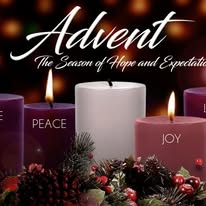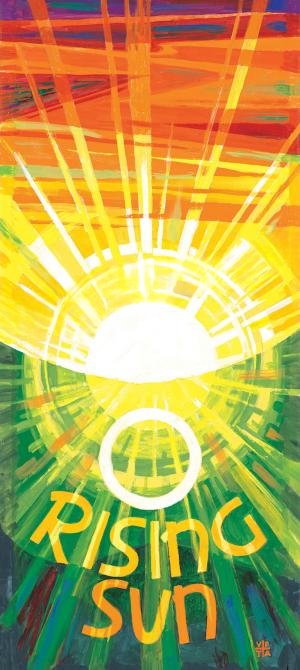About Today



Sunday 21 December 2025
4th Sunday of Advent
The Lord is at hand: come, let us adore him.
Year: A(II). Psalm week: 4. Liturgical Colour: Violet.
O Oriens!
O Oriens,
splendor lucis ætérnæ
et sol iustítiæ:
veni et illúmina sedéntes in ténebris et umbra mortis.
“O Rising Sun, you are the splendour of eternal light and the sun of justice: come and enlighten those who sit in darkness and in the shadow of death.”
Yesterday’s antiphon spoke of the people sitting in darkness and shadow and so does today’s, but there is a difference. The light of Christmas is very near. Jesus is nearly here. No longer do we look forward to being led out of our prison: now we look for his light to come and shine into the prison itself, dispelling its darkness.
Isaiah sees this future as a present: “The people that walked in darkness has seen a great light; on those who live in a land of deep shadow a light has shone.”
For five evenings now the Magnificat antiphon at Vespers has been counting down to the birth of Jesus. There are only two evenings left to go.
In other years: Saint Peter Canisius, priest, Doctor (1521 - 1597)
He was born in Nijmegen (now in the Netherlands) in 1521. He studied at Cologne and joined the Society of Jesus: he was ordained priest in 1546. He was sent to Germany, where for many years he worked hard to defend and strengthen the Catholic faith both by writing and by preaching. He wrote many books, of which The Catechism is particularly noteworthy. He died at Fribourg in Switzerland in 1597.
An angel of the Lord appeared to him in a dream, saying, ‘Joseph'...
Gospel: Matthew 1:18-24
Now the birth of Jesus Christ took place in this way. When his mother Mary had been betrothed to Joseph, before they came together she was found to be with child from the Holy Spirit. And her husband Joseph, being a just man and unwilling to put her to shame, resolved to send her away quietly. But as he considered these things, behold, an angel of the Lord appeared to him in a dream, saying, ‘Joseph, son of David, do not fear to take Mary as your wife, for that which is conceived in her is from the Holy Spirit. She will bear a son, and you shall call his name Jesus, for he will save his people from their sins.’
All this took place to fulfil what the Lord had spoken by the prophet:
‘Behold, the virgin shall conceive and bear a son,
and they shall call his name Emmanuel’ —
which means, God with us.
When Joseph woke from sleep, he did as the angel of the Lord commanded him: he took his wife.
Reflection on the painting
Matthew is the only Gospel writer who tells us about the four dreams of Joseph. Luke focuses on Mary; Mark and John do not include infancy narratives at all. But Matthew places Joseph at the centre of the early story, portraying him as a man who listens to God with a discerning, obedient heart. In Matthew’s Gospel, Joseph receives four divine messages in dreams: the first tells him not to be afraid to take Mary as his wife; the second warns him to flee to Egypt; the third tells him when it is safe to return; and the fourth directs him to settle in Galilee rather than Judea. The dream described in our reading today is Joseph’s moment of profound trust: the angel reveals that the child conceived in Mary is from the Holy Spirit, that this child will save His people from their sins, and Joseph is asked to take Mary into his home. Joseph awakens and obeys immediately. It is the Gospel writer’s way of showing us that, from the very beginning, God guides salvation history through the listening heart of a humble carpenter who responds promptly to the whisper of heaven.
I have always found it strange how Christian artists over the ages portray Joseph as an elderly, bearded man; more like a gentle grandfather than an active father. This artistic choice was intentional: by showing Joseph as old man and somewhat removed from the central action, painters underscored the Virgin Birth and protected the doctrine of Mary’s perpetual virginity. The older Joseph also symbolised humility, wisdom and quiet guardianship. He appears at the edge of Nativity scenes, often in shadow, his presence calm and understated. Over time this visual tradition shaped maybe somewhat wrongly how we think of Joseph — a figure whose role was to stand aside rather than stand strong.
El Greco’s St Joseph and the Christ Child offers a striking alternative. Here Joseph is not elderly or frail; he is young, vigorous, and full of life. He stands tall, elongated in El Greco’s distinctive style, with the Christ Child clinging to his legs in complete trust. Joseph looks down with tender strength, embodying the role of a true protector. Swirling angels and dramatic skies surround them, reminding us that this is a fatherhood woven into God’s great plan of salvation. This portrayal is far closer to the Joseph we meet in the Gospels: a courageous man who listens to God’s guidance in dreams, acts decisively, and shields Mary and Jesus with unwavering devotion.
St Joseph and the Christ Child,
Painted by Doménikos Theotokópoulos, most widely known as El Greco (1541-1614),
Painted circa 1600
Oil on canvas
4th Sunday of Advent
The Lord is at hand: come, let us adore him.
Year: A(II). Psalm week: 4. Liturgical Colour: Violet.
O Oriens!
O Oriens,
splendor lucis ætérnæ
et sol iustítiæ:
veni et illúmina sedéntes in ténebris et umbra mortis.
“O Rising Sun, you are the splendour of eternal light and the sun of justice: come and enlighten those who sit in darkness and in the shadow of death.”
Yesterday’s antiphon spoke of the people sitting in darkness and shadow and so does today’s, but there is a difference. The light of Christmas is very near. Jesus is nearly here. No longer do we look forward to being led out of our prison: now we look for his light to come and shine into the prison itself, dispelling its darkness.
Isaiah sees this future as a present: “The people that walked in darkness has seen a great light; on those who live in a land of deep shadow a light has shone.”
For five evenings now the Magnificat antiphon at Vespers has been counting down to the birth of Jesus. There are only two evenings left to go.
In other years: Saint Peter Canisius, priest, Doctor (1521 - 1597)
He was born in Nijmegen (now in the Netherlands) in 1521. He studied at Cologne and joined the Society of Jesus: he was ordained priest in 1546. He was sent to Germany, where for many years he worked hard to defend and strengthen the Catholic faith both by writing and by preaching. He wrote many books, of which The Catechism is particularly noteworthy. He died at Fribourg in Switzerland in 1597.
An angel of the Lord appeared to him in a dream, saying, ‘Joseph'...
Gospel: Matthew 1:18-24
Now the birth of Jesus Christ took place in this way. When his mother Mary had been betrothed to Joseph, before they came together she was found to be with child from the Holy Spirit. And her husband Joseph, being a just man and unwilling to put her to shame, resolved to send her away quietly. But as he considered these things, behold, an angel of the Lord appeared to him in a dream, saying, ‘Joseph, son of David, do not fear to take Mary as your wife, for that which is conceived in her is from the Holy Spirit. She will bear a son, and you shall call his name Jesus, for he will save his people from their sins.’
All this took place to fulfil what the Lord had spoken by the prophet:
‘Behold, the virgin shall conceive and bear a son,
and they shall call his name Emmanuel’ —
which means, God with us.
When Joseph woke from sleep, he did as the angel of the Lord commanded him: he took his wife.
Reflection on the painting
Matthew is the only Gospel writer who tells us about the four dreams of Joseph. Luke focuses on Mary; Mark and John do not include infancy narratives at all. But Matthew places Joseph at the centre of the early story, portraying him as a man who listens to God with a discerning, obedient heart. In Matthew’s Gospel, Joseph receives four divine messages in dreams: the first tells him not to be afraid to take Mary as his wife; the second warns him to flee to Egypt; the third tells him when it is safe to return; and the fourth directs him to settle in Galilee rather than Judea. The dream described in our reading today is Joseph’s moment of profound trust: the angel reveals that the child conceived in Mary is from the Holy Spirit, that this child will save His people from their sins, and Joseph is asked to take Mary into his home. Joseph awakens and obeys immediately. It is the Gospel writer’s way of showing us that, from the very beginning, God guides salvation history through the listening heart of a humble carpenter who responds promptly to the whisper of heaven.
I have always found it strange how Christian artists over the ages portray Joseph as an elderly, bearded man; more like a gentle grandfather than an active father. This artistic choice was intentional: by showing Joseph as old man and somewhat removed from the central action, painters underscored the Virgin Birth and protected the doctrine of Mary’s perpetual virginity. The older Joseph also symbolised humility, wisdom and quiet guardianship. He appears at the edge of Nativity scenes, often in shadow, his presence calm and understated. Over time this visual tradition shaped maybe somewhat wrongly how we think of Joseph — a figure whose role was to stand aside rather than stand strong.
El Greco’s St Joseph and the Christ Child offers a striking alternative. Here Joseph is not elderly or frail; he is young, vigorous, and full of life. He stands tall, elongated in El Greco’s distinctive style, with the Christ Child clinging to his legs in complete trust. Joseph looks down with tender strength, embodying the role of a true protector. Swirling angels and dramatic skies surround them, reminding us that this is a fatherhood woven into God’s great plan of salvation. This portrayal is far closer to the Joseph we meet in the Gospels: a courageous man who listens to God’s guidance in dreams, acts decisively, and shields Mary and Jesus with unwavering devotion.
St Joseph and the Christ Child,
Painted by Doménikos Theotokópoulos, most widely known as El Greco (1541-1614),
Painted circa 1600
Oil on canvas